|
Outstanding Paper
|
Oral
[ Halle A 8 - 9 ] 
Abstract
We resolve difficulties in training and sampling from a discrete generative model by learning a smoothed energy function, sampling from the smoothed data manifold with Langevin Markov chain Monte Carlo (MCMC), and projecting back to the true data manifold with one-step denoising. Our $\textit{Discrete Walk-Jump Sampling}$ formalism combines the contrastive divergence training of an energy-based model and improved sample quality of a score-based model, while simplifying training and sampling by requiring only a single noise level. We evaluate the robustness of our approach on generative modeling of antibody proteins and introduce the $\textit{distributional conformity score}$ to benchmark protein generative models. By optimizing and sampling from our models for the proposed distributional conformity score, 97-100\% of generated samples are successfully expressed and purified and 70\% of functional designs show equal or improved binding affinity compared to known functional antibodies on the first attempt in a single round of laboratory experiments. We also report the first demonstration of long-run fast-mixing MCMC chains where diverse antibody protein classes are visited in a single MCMC chain.
|
|
Outstanding Paper
|
Oral
[ Halle A 7 ] 
AbstractGenerative models trained on internet data have revolutionized how text, image, and video content can be created. Perhaps the next milestone for generative models is to simulate realistic experience in response to actions taken by humans, robots, and other interactive agents. Applications of a real-world simulator range from controllable content creation in games and movies, to training embodied agents purely in simulation that can be directly deployed in the real world. We explore the possibility of learning a universal simulator (UniSim) of real-world interaction through generative modeling. We first make the important observation that natural datasets available for learning a real-world simulator are often rich along different axes (e.g., abundant objects in image data, densely sampled actions in robotics data, and diverse movements in navigation data). With careful orchestration of diverse datasets, each providing a different aspect of the overall experience, UniSim can emulate how humans and agents interact with the world by simulating the visual outcome of both high-level instructions such as “open the drawer” and low-level controls such as “move by x,y” from otherwise static scenes and objects. There are numerous use cases for such a real-world simulator. As an example, we use UniSim to train both high-level … |
|
Outstanding Paper
Honorable Mention
|
Oral
[ Halle A 3 ] 
AbstractDesigning expressive Graph Neural Networks (GNNs) is a fundamental topic in the graph learning community. So far, GNN expressiveness has been primarily assessed via the Weisfeiler-Lehman (WL) hierarchy. However, such an expressivity measure has notable limitations: it is inherently coarse, qualitative, and may not well reflect practical requirements (e.g., the ability to encode substructures). In this paper, we introduce a novel framework for quantitatively studying the expressiveness of GNN architectures, addressing all the above limitations. Specifically, we identify a fundamental expressivity measure termed homomorphism expressivity, which quantifies the ability of GNN models to count graphs under homomorphism. Homomorphism expressivity offers a complete and practical assessment tool: the completeness enables direct expressivity comparisons between GNN models, while the practicality allows for understanding concrete GNN abilities such as subgraph counting. By examining four classes of prominent GNNs as case studies, we derive simple, unified, and elegant descriptions of their homomorphism expressivity for both invariant and equivariant settings. Our results provide novel insights into a series of previous work, unify the landscape of different subareas in the community, and settle several open questions. Empirically, extensive experiments on both synthetic and real-world tasks verify our theory, showing that the practical performance of GNN models … |
|
Outstanding Paper
|
Oral
[ Halle A 2 ] 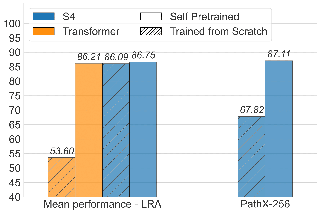
AbstractModeling long-range dependencies across sequences is a longstanding goal in machine learning and has led to architectures, such as state space models, that dramatically outperform Transformers on long sequences. However, these impressive empirical gains have been by and large demonstrated on benchmarks (e.g. Long Range Arena), where models are randomly initialized and trained to predict a target label from an input sequence. In this work, we show that random initialization leads to gross overestimation of the differences between architectures and that pretraining with standard denoising objectives, using only the downstream task data, leads to dramatic gains across multiple architectures and to very small gaps between Transformers and state space models (SSMs). In stark contrast to prior works, we find vanilla Transformers to match the performance of S4 on Long Range Arena when properly pretrained, and we improve the best reported results of SSMs on the PathX-256 task by 20 absolute points. Subsequently, we analyze the utility of previously-proposed structured parameterizations for SSMs and show they become mostly redundant in the presence of data-driven initialization obtained through pretraining. Our work shows that, when evaluating different architectures on supervised tasks, incorporation of data-driven priors via pretraining is essential for reliable performance … |
|
Outstanding Paper
|
Oral
[ Halle A 7 ] 
AbstractTransformers have recently emerged as a powerful tool for learning visual representations. In this paper, we identify and characterize artifacts in feature maps of both supervised and self-supervised ViT networks. The artifacts correspond to high-norm tokens appearing during inference primarily in low-informative background areas of images, that are repurposed for internal computations. We propose a simple yet effective solution based on providing additional tokens to the input sequence of the Vision Transformer to fill that role. We show that this solution fixes that problem entirely for both supervised and self-supervised models, sets a new state of the art for self-supervised visual models on dense visual prediction tasks, enables object discovery methods with larger models, and most importantly leads to smoother feature maps and attention maps for downstream visual processing. |
|
Honorable Mention
|
Oral
[ Halle A 7 ] 
AbstractWe propose Riemannian Flow Matching (RFM), a simple yet powerful framework for training continuous normalizing flows on manifolds. Existing methods for generative modeling on manifolds either require expensive simulation, are inherently unable to scale to high dimensions, or use approximations for limiting quantities that result in biased training objectives. Riemannian Flow Matching bypasses these limitations and offers several advantages over previous approaches: it is simulation-free on simple geometries, does not require divergence computation, and computes its target vector field in closed-form. The key ingredient behind RFM is the construction of a relatively simple premetric for defining target vector fields, which encompasses the existing Euclidean case. To extend to general geometries, we rely on the use of spectral decompositions to efficiently compute premetrics on the fly. Our method achieves state-of-the-art performance on real-world non-Euclidean datasets, and we demonstrate tractable training on general geometries, including triangular meshes with highly non-trivial curvature and boundaries. |
|
Honorable Mention
|
Oral
[ Halle A 2 ] 
AbstractIn this study, we introduce adaptive KV cache compression, a plug-and-play method that reduces the memory footprint of generative inference for Large Language Models (LLMs). Different from the conventional KV cache that retains key and value vectors for all context tokens, we conduct targeted profiling to discern the intrinsic structure of attention modules. Based on the recognized structure, we then construct the KV cache in an adaptive manner: evicting long-range contexts on attention heads emphasizing local contexts, discarding non-special tokens on attention heads centered on special tokens, and only employing the standard KV cache for attention heads that broadly attend to all tokens. Moreover, with the lightweight attention profiling used to guide the construction of the adaptive KV cache, FastGen can be deployed without resource-intensive fine-tuning or re-training. In our experiments across various asks, FastGen demonstrates substantial reduction on GPU memory consumption with negligible generation quality loss. We will release our code and the compatible CUDA kernel for reproducibility. |
|
Honorable Mention
|
Oral
[ Halle A 3 ] 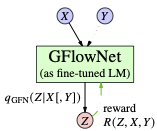
AbstractAutoregressive large language models (LLMs) compress knowledge from their training data through next-token conditional distributions. This limits tractable querying of this knowledge to start-to-end autoregressive sampling. However, many tasks of interest---including sequence continuation, infilling, and other forms of constrained generation---involve sampling from intractable posterior distributions. We address this limitation by using amortized Bayesian inference to sample from these intractable posteriors. Such amortization is algorithmically achieved by fine-tuning LLMs via diversity-seeking reinforcement learning algorithms: generative flow networks (GFlowNets). We empirically demonstrate that this distribution-matching paradigm of LLM fine-tuning can serve as an effective alternative to maximum-likelihood training and reward-maximizing policy optimization. As an important application, we interpret chain-of-thought reasoning as a latent variable modeling problem and demonstrate that our approach enables data-efficient adaptation of LLMs to tasks that require multi-step rationalization and tool use. |
|
Honorable Mention
|
Oral
[ Halle A 3 ] 
AbstractIt has long been hypothesised that causal reasoning plays a fundamental role in robust and general intelligence. However, it is not known if agents must learn causal models in order to generalise to new domains, or if other inductive biases are sufficient. We answer this question, showing that any agent capable of satisfying a regret bound for a large set of distributional shifts must have learned an approximate causal model of the data generating process, which converges to the true causal model for optimal agents. We discuss the implications of this result for several research areas including transfer learning and causal inference. |
|
Outstanding Paper
Honorable Mention
|
Oral
[ Halle A 3 ] 
AbstractDesigning expressive Graph Neural Networks (GNNs) is a fundamental topic in the graph learning community. So far, GNN expressiveness has been primarily assessed via the Weisfeiler-Lehman (WL) hierarchy. However, such an expressivity measure has notable limitations: it is inherently coarse, qualitative, and may not well reflect practical requirements (e.g., the ability to encode substructures). In this paper, we introduce a novel framework for quantitatively studying the expressiveness of GNN architectures, addressing all the above limitations. Specifically, we identify a fundamental expressivity measure termed homomorphism expressivity, which quantifies the ability of GNN models to count graphs under homomorphism. Homomorphism expressivity offers a complete and practical assessment tool: the completeness enables direct expressivity comparisons between GNN models, while the practicality allows for understanding concrete GNN abilities such as subgraph counting. By examining four classes of prominent GNNs as case studies, we derive simple, unified, and elegant descriptions of their homomorphism expressivity for both invariant and equivariant settings. Our results provide novel insights into a series of previous work, unify the landscape of different subareas in the community, and settle several open questions. Empirically, extensive experiments on both synthetic and real-world tasks verify our theory, showing that the practical performance of GNN models … |
|
Honorable Mention
|
Oral
[ Halle A 2 ] 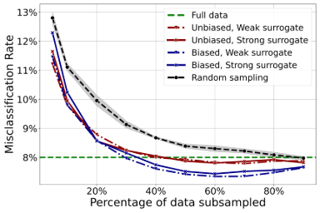
Abstract
Given a sample of size N, it is often useful to select a subsample of smaller size n < N to be used for statistical estimation or learning. Such a data selection step is useful to reduce the requirements of data labeling and the computational complexity of learning. We assume to be given N unlabeled samples $x_{i}$, and to be given access to a 'surrogate model' that can predict labels $y_i$ better than random guessing. Our goal is to select a subset of the samples, to be denoted by {$x_{i}$}$_{i\in G}$, of size $|G|=n < N$. We then acquire labels for this set and we use them to train a model via regularized empirical risk minimization. By using a mixture of numerical experiments on real and synthetic data, and mathematical derivations under low- and high- dimensional asymptotics, we show that: (i) Data selection can be very effective, in particular beating training on the full sample in some cases; (ii) Certain popular choices in data selection methods (e.g. unbiased reweighted subsampling, or influence function-based subsampling) can be substantially suboptimal.
|
|
Honorable Mention
|
Oral
[ Halle A 3 ] 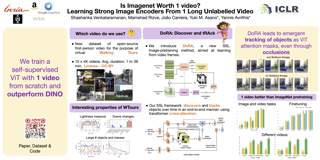
AbstractSelf-supervised learning has unlocked the potential of scaling up pretraining to billions of images, since annotation is unnecessary. But are we making the best use of data? How more economical can we be? In this work, we attempt to answer this question by making two contributions. First, we investigate first-person videos and introduce a |
|
Honorable Mention
|
Oral
[ Halle A 7 ] 
AbstractLarge language models are trained on vast amounts of internet data, prompting concerns that they have memorized public benchmarks. Detecting this type of contamination is challenging because the pretraining data used by proprietary models are often not publicly accessible.We propose a procedure for detecting test set contamination of language models with exact false positive guarantees and without access to pretraining data or model weights. Our approach leverages the fact that when there is no data contamination, all orderings of an exchangeable benchmark should be equally likely. In contrast, the tendency for language models to memorize example order means that a contaminated language model will find certain canonical orderings to be much more likely than others. Our test flags potential contamination whenever the likelihood of a canonically ordered benchmark dataset is significantly higher than the likelihood after shuffling the examples.We demonstrate that our procedure is sensitive enough to reliably detect contamination in challenging situations, including models as small as 1.4 billion parameters, on small test sets only 1000 examples, and datasets that appear only a few times in the pretraining corpus. Finally, we evaluate LLaMA-2 to apply our test in a realistic setting and find our results to be consistent with … |
|
Honorable Mention
|
Oral
[ Halle A 2 ] 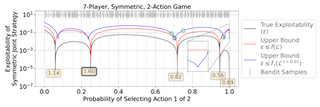
AbstractWe propose the first loss function for approximate Nash equilibria of normal-form games that is amenable to unbiased Monte Carlo estimation. This construction allows us to deploy standard non-convex stochastic optimization techniques for approximating Nash equilibria, resulting in novel algorithms with provable guarantees. We complement our theoretical analysis with experiments demonstrating that stochastic gradient descent can outperform previous state-of-the-art approaches. |
|
Honorable Mention
|
Oral
[ Halle A 2 ] 
AbstractRegularization-based methods have so far been among the de facto choices for continual learning. Recent theoretical studies have revealed that these methods all boil down to relying on the Hessian matrix approximation of model weights. However, these methods suffer from suboptimal trade-offs between knowledge transfer and forgetting due to fixed and unchanging Hessian estimations during training.Another seemingly parallel strand of Meta-Continual Learning (Meta-CL) algorithms enforces alignment between gradients of previous tasks and that of the current task. In this work we revisit Meta-CL and for the first time bridge it with regularization-based methods. Concretely, Meta-CL implicitly approximates Hessian in an online manner, which enjoys the benefits of timely adaptation but meantime suffers from high variance induced by random memory buffer sampling. We are thus highly motivated to combine the best of both worlds, through the proposal of Variance Reduced Meta-CL (VR-MCL) to achieve both timely and accurate Hessian approximation.Through comprehensive experiments across three datasets and various settings, we consistently observe that VR-MCL outperforms other SOTA methods, which further validates the effectiveness of VR-MCL. |
|
Honorable Mention
|
Oral
[ Halle A 3 ] 
AbstractTransformer models exhibit in-context learning: the ability to accurately predict the response to a novel query based on illustrative examples in the input sequence, which contrasts with traditional in-weights learning of query-output relationships. What aspects of the training data distribution and architecture favor in-context vs in-weights learning? Recent work has shown that specific distributional properties inherent in language, such as burstiness, large dictionaries and skewed rank-frequency distributions, control the trade-off or simultaneous appearance of these two forms of learning. We first show that these results are recapitulated in a minimal attention-only network trained on a simplified dataset. In-context learning (ICL) is driven by the abrupt emergence of an induction head, which subsequently competes with in-weights learning. By identifying progress measures that precede in-context learning and targeted experiments, we construct a two-parameter model of an induction head which emulates the full data distributional dependencies displayed by the attention-based network. A phenomenological model of induction head formation traces its abrupt emergence to the sequential learning of three nested logits enabled by an intrinsic curriculum. We propose that the sharp transitions in attention-based networks arise due to a specific chain of multi-layer operations necessary to achieve ICL, which is implemented by nested nonlinearities … |